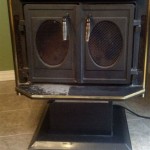Antique Fireplace Surrounds: A Timeless Elegance
Antique fireplace surrounds are more than just decorative elements; they are historical artifacts that contribute significantly to the character and value of a home. These surrounds, often crafted from materials like marble, wood, or cast iron, represent various architectural periods and design sensibilities. Understanding the nuances of antique fireplace surrounds, from their historical context to their restoration and maintenance, is essential for homeowners, collectors, and interior design enthusiasts alike.
The appeal of antique fireplace surrounds lies in their unique craftsmanship and the stories they hold. Each surround tells a tale of the past, reflecting the social, economic, and artistic trends of its era. These features serve as focal points within a room, adding a layer of sophistication and historical depth that modern alternatives simply cannot replicate. The enduring popularity of antique fireplace surrounds stems from their ability to seamlessly blend with both traditional and contemporary interiors, creating a balanced and visually appealing aesthetic.
Identifying and Dating Antique Fireplace Surrounds
Authenticating and dating antique fireplace surrounds require a keen eye for detail and a comprehensive understanding of historical design styles. Several factors contribute to accurate identification, including the material used, the design motifs, and any manufacturer's marks or signatures present.
Material Analysis
: The materials used in the construction of the surround are crucial indicators of its age and origin. Marble was a popular choice for affluent households during the Victorian and Edwardian periods, often featuring intricate carvings and polished surfaces. Wood surrounds, particularly those made of oak, mahogany, or walnut, were common in more modest homes and often showcase simpler, yet elegant, designs. Cast iron surrounds gained popularity during the Industrial Revolution, offering durability and affordability. Analyzing the type of material and its condition can provide valuable clues about the surround's age and previous environment.Design Motifs and Architectural Styles
: The design motifs incorporated into the surround are indicative of specific architectural periods. For instance, Georgian surrounds often feature symmetrical designs, classical columns, and delicate carvings. Victorian surrounds are characterized by elaborate ornamentation, including floral patterns, scrolls, and intricate detailing. Art Nouveau surrounds showcase flowing lines, organic shapes, and stylized representations of nature. Art Deco surrounds, prevalent in the 1920s and 1930s, exhibit geometric patterns, streamlined shapes, and a sense of modern elegance. Identifying the prevalent design motifs helps narrow down the period of origin.Manufacturer's Marks and Signatures
: Searching for manufacturer's marks, signatures, or patent numbers can provide definitive evidence of the surround's age and origin. These markings are typically found on the back of the surround or in less conspicuous areas. Consulting historical resources, such as trade catalogs, design books, and online databases, can help decipher these markings and identify the manufacturer. This information can be invaluable in confirming the authenticity and provenance of the surround.Furthermore, comparing the surround to known examples from specific periods and regions can aid in the authentication process. Consulting with experts in antique furniture and architectural salvage can provide additional insights and validation.
Restoration and Preservation of Antique Fireplace Surrounds
Restoring and preserving antique fireplace surrounds require a careful and methodical approach to maintain their historical integrity and aesthetic appeal. Improper restoration techniques can damage the surround and diminish its value. Therefore, it is essential to employ methods that are sympathetic to the original materials and construction techniques.
Cleaning and Surface Treatment
: Cleaning antique fireplace surrounds depends on the material of construction. Marble surrounds should be cleaned with a mild, pH-neutral soap and water solution, avoiding abrasive cleaners that can scratch the surface. Wood surrounds can be cleaned with a soft cloth and a wood-specific cleaner, followed by a polish to restore the luster. Cast iron surrounds may require more aggressive cleaning to remove rust and grime, using wire brushes and specialized rust removers. After cleaning, applying a protective sealant or wax can help prevent future damage.Repairing Damage and Replacing Missing Elements
: Addressing damage, such as cracks, chips, or missing elements, requires skilled craftsmanship and the use of appropriate materials. Marble repairs can be accomplished with epoxy resins or specialized marble fillers, carefully color-matched to the original stone. Wood repairs often involve patching with wood filler or replacing damaged sections with reclaimed wood that closely matches the original. Cast iron repairs may require welding or the fabrication of replacement parts by a skilled blacksmith. The goal is to seamlessly integrate the repairs with the existing material, preserving the original appearance of the surround.Refinishing and Repainting
: Refinishing or repainting antique fireplace surrounds should be approached with caution, as these processes can alter the original appearance and potentially diminish the value. If refinishing is necessary, it is crucial to use historically accurate paints and finishes. Removing old paint layers should be done carefully, using chemical strippers or heat guns, avoiding harsh abrasives that can damage the underlying surface. When repainting, choosing colors and finishes that are consistent with the historical period can help maintain the integrity of the surround.Consulting with professional restorers who specialize in antique furniture and architectural elements is recommended. These experts possess the knowledge and skills to perform restoration work that preserves the historical character and value of the surround.
Integrating Antique Fireplace Surrounds into Modern Interiors
Antique fireplace surrounds can be seamlessly integrated into modern interiors, creating a harmonious blend of old and new. The key is to balance the historical character of the surround with the contemporary elements of the room, creating a cohesive and aesthetically pleasing space.
Selecting the Right Surround
: The choice of surround should complement the overall style of the interior. A grand Victorian surround may be well-suited for a room with high ceilings and traditional furnishings, while a sleek Art Deco surround may be more appropriate for a modern, minimalist space. The size and scale of the surround should also be considered, ensuring that it is proportionate to the room and does not overwhelm the space.Juxtaposing Old and New
: Creating a visually interesting contrast between the antique surround and contemporary furnishings can enhance the overall aesthetic. Pairing a traditional marble surround with modern furniture and artwork can create a striking focal point. Conversely, placing a sleek, minimalist surround in a room with antique furniture can provide a sense of balance and sophistication. The key is to find a harmonious balance that reflects the homeowner's personal style.Color Palette and Accessories
: The color palette and accessories used in the room should complement the antique surround. Neutral colors, such as whites, grays, and beiges, can provide a backdrop that allows the surround to stand out. Incorporating natural materials, such as wood, stone, and metal, can create a sense of warmth and texture. Accessories, such as candles, books, and decorative objects, can be used to enhance the overall ambiance of the room.Functionality and Modernization
: While preserving the historical character of the surround is important, incorporating modern functionality can enhance its usability. Installing a gas or electric fireplace insert can provide efficient heating while maintaining the aesthetic appeal of the surround. Integrating modern lighting solutions, such as recessed lighting or sconces, can highlight the surround and create a warm and inviting atmosphere.Ultimately, integrating an antique fireplace surround into a modern interior is about creating a space that is both stylish and functional, reflecting the homeowner's appreciation for history and design. Through careful planning and attention to detail, these historical artifacts can be seamlessly incorporated into contemporary living spaces, adding a touch of timeless elegance and sophistication.

Vintage Fireplace Mantel Recycling The Past Architectural Salvage

Antique French Limestone And Marble Fireplace Mantels For Interiors Historic Decorative Materials A Division Of Pavé Tile Wood Stone Inc

Rustic Charm Full Surround Fireplace Mantel Antique Wood

Antique Wood Marble Carved Fireplace Mantels Oley Valley Architectural Antiques

Vintage Fireplace Mantel Install Decorating Ideas

Antique Wood Marble Carved Fireplace Mantels Oley Valley Architectural Antiques

Antique Wooden Fireplace Mantel Carved With Satyr And Columns 19th Century Italy For At 1stdibs Wood Surround Mantels

Antique French Limestone And Marble Fireplace Mantels For Interiors Historic Decorative Materials A Division Of Pavé Tile Wood Stone Inc

Vintage Fireplace Mantel Install Decorating Ideas

Original And Amazingly Intact 1880 S Antique American Eastlake Style Tennessee Marble Fireplace Mantel Salvaged From A
Related Posts








